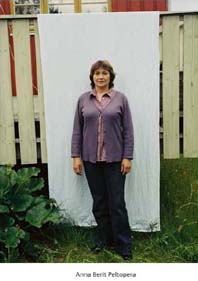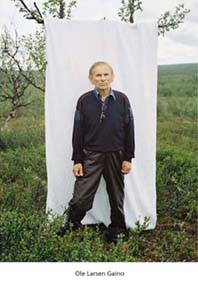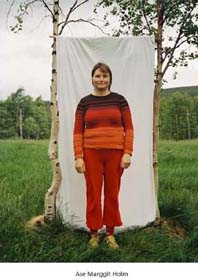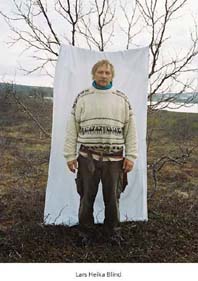|
Angelika Böck Seek Me |
Galerie Peter Herrmann |
Prof. Dr. Randi Gunzenhäuser. 2005 This sound and image installation consists of five projection surfaces that form a pentagonal space without allowing the projections to come into direct contact with each other. The life-sized photographic portrait of a musician is projected onto each surface, and positioned above each portrait is a loudspeaker that beams out its sound after the fashion of a sound shower in a circular area corresponding to the width of the portrait. Thus, a sound space is formed before each of the walls, and each musician depicted is matched with his or her composition. In the spaces between the pictures, the music is barely audible, while at the center of the installation the sound spaces overlap to create a five-part choir. |
 |
Visitors can either listen to an individual voice directly in front of a portrait, they can switch back and forth between the individual voices while passing through the silence between the sound corridors, or they can absorb all the melodies together in the middle of the arrangement. In the center, the compositions all mix together, but they also differentiate themselves – here is where the harmonies and dissonances of rhythm, structure and key in the various melodies can be compared. |
 |
For the experimental layout “Seek Me”, Angelika Böck worked together with five Sami singers from Norway, Sweden and Finland: Lars Heika Blind, a reindeer herder from Karesuando, Ase Marggit Holm, a journalist from Usjoki, Ole Larsen Gaino, a reindeer herder from Kautokeino, Anna Berrit Peltopera, a tailor and taxi driver from Karasjok, and Johan Sara, jr., a composer and musician from Maze. The aboriginal Sami, who call themselves Sámpi, today constitute an ethnic minority in Norway, Finland, Sweden and on the Russian peninsula Kola and have their own language and culture. The Sami maintain the ancient and unique musical tradition of the yoik, an overtonal song with which they portray people, animals and landscapes. Similar in some respects to the Alpine yodeler, the yoik consists of artfully arranged, richly vocal sequences of syllables that do not form a coherent word text and are sometimes accompanied by instruments but usually are not. Johan Sara, jr., whose father and grandfather were also famous yoikers, emphasizes that a yoik does not simply describe the character of the object from an outside perspective: “I don’t sing about the mountain, I sing the mountain; I don’t sing about the creek, I become the creek.” The yoiker conjures up the feeling that his object is present and then places himself in his object. |
The object of the five compositions, as before with “StillePost”, is the German artist herself. A yoik about a person is traditionally seen as a present to them. “Seek Me”, however, is paid commission work. Through the yoik, the singer establishes a relationship with the object, delves into its essence. |
The yoik does not supply a description of a person but rather serves to actively recall her or him. Angelika Böck asked the yoikers, who are all acquainted with each other, to create a musical “portrait” of her. In order to make herself familiar to them, the artist lived with the participants and accompanied them in their daily lives. When a musician had become sufficiently acquainted with her, he or she composed Angelika’s yoik. For her part, the German artist made photographic portraits of the singers. She heard their yoiks for the first time when they were recorded in the studio. |
 |
“Seek Me” explores this form of personal characterization and remembrance typical of the indigenous nomadic Sami people. It is not the face, so central to western art, which supplies the inspiration for the yoik’s characterization. |
 |
For the yoiker it is much more important to express the essence of a landscape just as that of a person by establishing contact with the object. The portrayed object becomes interesting at precisely those places where it meets the singer, where interaction creates a movement, arousing feelings and tones. The melodies make it possible to discern the tracks the object leaves behind – repeated over and over, changed a little bit each time, circling their themes. As with "Frage-ment" and "StillePost", Angelika Böck acts as a mediation mechanism between parties and cultures. She initiated the project, is the object of the songs, but, for her part, she photographed the singers and made them part of her installation and of our perception. Viewers actively step into the realms of two traditions of representation which emphasize each other within the installation. The songs call Angelika Böck by her musical name, while Angelika Böck introduces the singers to us and draws us into the circle of listeners.
|